Menu
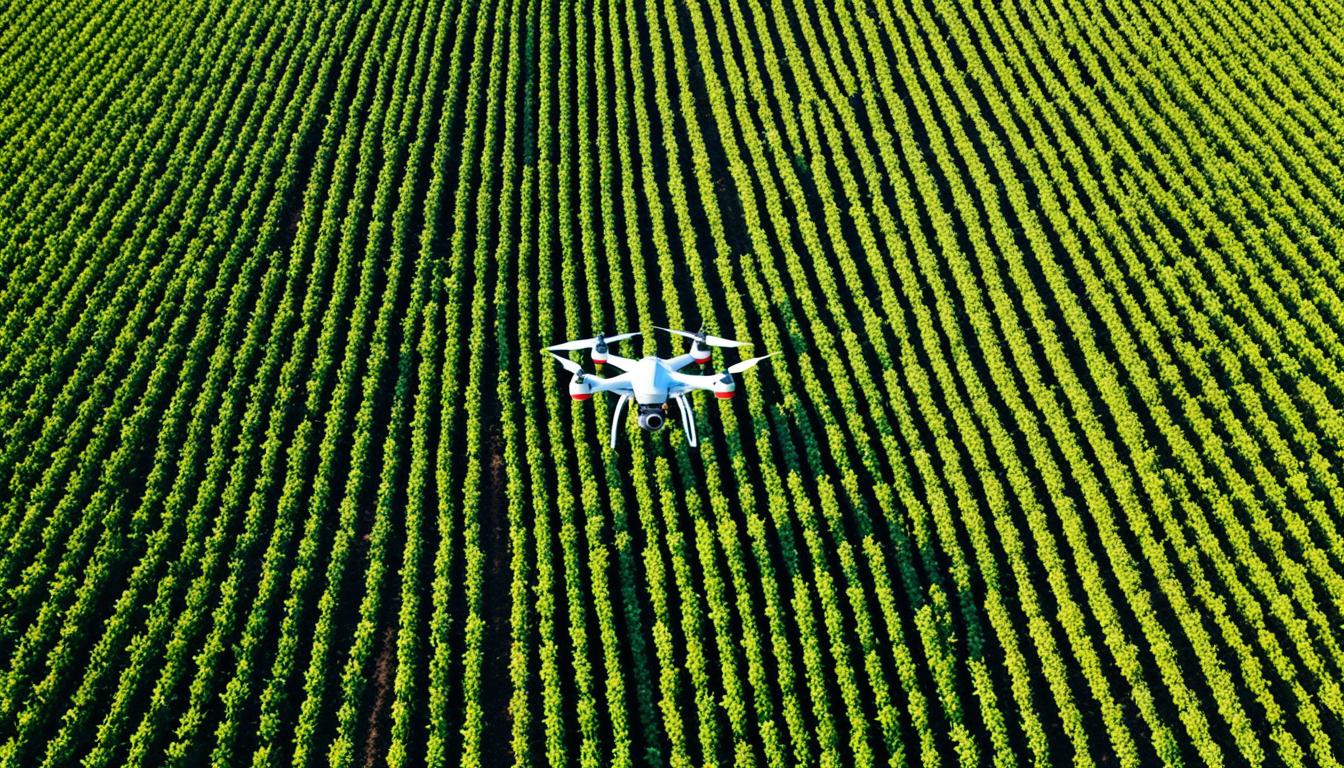
Gulf countries have tough agricultural conditions like arid weather and small farmable areas. But, they are now at the forefront of a farming revolution. Thanks to agricultural drones, the way they farm is changing fast.
This drone tech in agriculture is all about precise farming. Drones take high-quality pictures and gather important data as they fly. This data shows farmers how to use their resources better, making farming both efficient and sustainable. Plus, drones are great at spreading things like pesticides and fertilizers, which saves time and cuts costs.
But, moving to this new technology isn’t simple. There are rules to follow, and farmers need special training to use drones. It can cost a lot at the start. But the advantages are huge: more crops, more money, and a chance to use AI-driven drones in the future. These drones could solve farm problems on their own, in real time.
Agricultural drones, or ag drones, are changing the game in farming. Especially in tough places like the Gulf. They use high-tech sensors and cameras to help farmers work better. This is important for places with little rainfall and not much space for crops.
Ag drones give farmers quick info about their crops and soil. This helps with watering the plants just right. It also helps farmers stick to eco-friendly farm methods. But, there are problems like tough rules and the drones’ cost. Still, using drones in farming more and smarter could do a lot of good for the farming world.
Making sure people fly these drones well and safely is key. In America, if drone rules were less strict, it could bring in a lot of money and jobs by 2025. Right now, there are some tests for drone pilots. But, more training is needed to keep things safe and working well.
However, too many rules can stop farming from getting even better with cool tech like auto-piloting and anti-crash systems. Countries that are more open about drone rules are seeing the most progress in farming tech. This shows that rules should help, not block, progress.
We still have a long way to go. But, lots of people and money going into new farming ways with drones show big changes are coming. This change will make farming better, stronger, and more eco-friendly. Drones in farming are leading us towards a future with smarter, greener farms.
Precision agriculture is changing how we grow crops. It uses advanced tools like drones and high-tech imaging to make farming more efficient and green. These tools give farmers detailed info on their crops. This helps them use resources wisely, saving money and the planet.
Drones are key in precision farming. They fly over fields taking detailed pictures. These images help farmers know what their crops need. By acting fast, they can stop diseases and save their harvests. For example, using drones cuts down on harmful chemicals by 70% and boosts farm outputs by 20%.
New imaging tech is changing how we look after crops. Drones with special cameras can spot plant issues before humans can. This means farmers can act early to protect their crops. They also help in using fertilisers just right, saving money and the environment.
Drones from companies like Dendra Systems and XAG can do big jobs fast. They can plant seeds over big areas very quickly. This shows how modern farming can be big, efficient, and good for the Earth.
The usage of UAVs, or drones, in agriculture is a game-changer. These tools help farmers work smarter, not harder. Drones bring a bird’s-eye view, checking crop health and soil quickly.
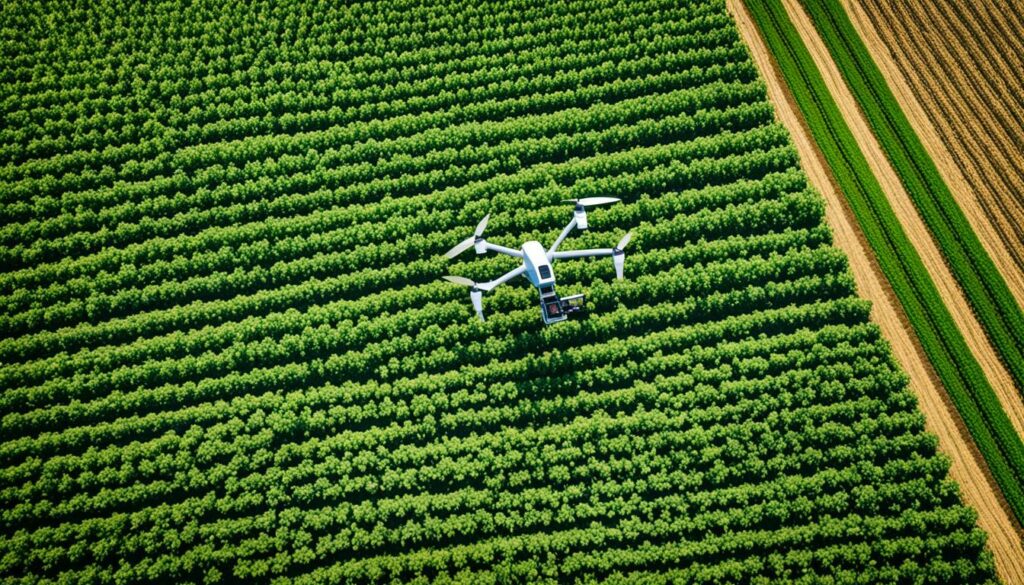
Drones save a lot of time and effort. Instead of walking miles around fields, JOUAV drones can fly for up to 480 minutes and cover 200km. They play a big role in how modern farms are managed.
The drone market in agriculture is growing fast. By 2030, it could be worth $18.22 billion, with a yearly increase of 20.3%. Drones don’t just help farms make more money, they save costs too. By using drone info, farms can use less harmful chemicals, spend less, and help the planet.
Drones are also great at spotting diseases early, which can up crop quality by 25%. They’re smart about where they drop chemicals, using 35% less. This saves the earth and makes farming more efficient. Different drone types each have their strengths, from covering lots of space fast to detailed checks on crops.
The study of remote sensing in agriculture lays the groundwork for today’s smart farming methods. It uses various types of imaging technology, like multispectral and hyperspectral scans and thermal imaging. These tools give farmers highly detailed data, which is vital for closely watching crops and acting quickly when needed.
Since the early 70s when the Landsat series first launched, remote sensing has gotten much better. Now, we can observe crop health and the environment in great detail. However, seeing clearly from space can be hard because of clouds. This means that sometimes, we can’t track crops as well as we’d like.
Drones have become crucial in remote sensing in agriculture. In a project spanning 20 US states since 2016, researchers are looking for the best drone systems. Their work focuses on making drones that are not only good for the job but also affordable and easy to use. These drones are then used for tracking pests, diseases, and checking water quality over large areas.
Universities are key in spreading knowledge about these technologies. They do this through workshops, training, and sharing online materials. Because of these efforts, they won the 2022 National Excellence in Multistate Research Award. It shows their big role in growing precision farming technology and protecting the environment.
The heart of all this is agricultural data analytics. Understanding the data we get from remote sensing helps farmers make smart choices. It lets them grow more food while taking care of the land. Artificial intelligence and machine learning are being used to make this process even smarter and quicker.
The ability to obtain detailed, real-time data through remote sensing has revolutionised how farmers manage their crops, leading to enhanced profitability and sustainable agricultural practices.
Here, you can see how different types of drones compare for use in farming:
| Type | Efficiency | Applications |
|---|---|---|
| Fixed-wing | High | Large scale monitoring |
| Single-rotor | Medium | Detailed scanning |
| Multi-rotor | Medium | Small area surveys |
| Hybrid | High | Versatile applications |
The field of remote sensing in agriculture and precision farming technology is always moving forward. These new tools and methods hold a lot of promise. They can help farmers work more efficiently and look after the environment better. With sophisticated data analysis, farmers are ready to face the challenges of growing food in our modern world.
Drone-based irrigation is a huge step forward in managing water smartly. It helps cut down on water use and supports green farming methods. Drones use special cameras to check on crops, see if they need more water, and figure out what nutrients they might lack. This helps farmers use water in the best way.
In Nigeria, drones have helped create better ways to grow rice. They could map out 1,000 hectares in a day, which was much faster than before. And in Malawi, drones have been used to look at crop amounts during droughts. This has really helped smaller farmers.
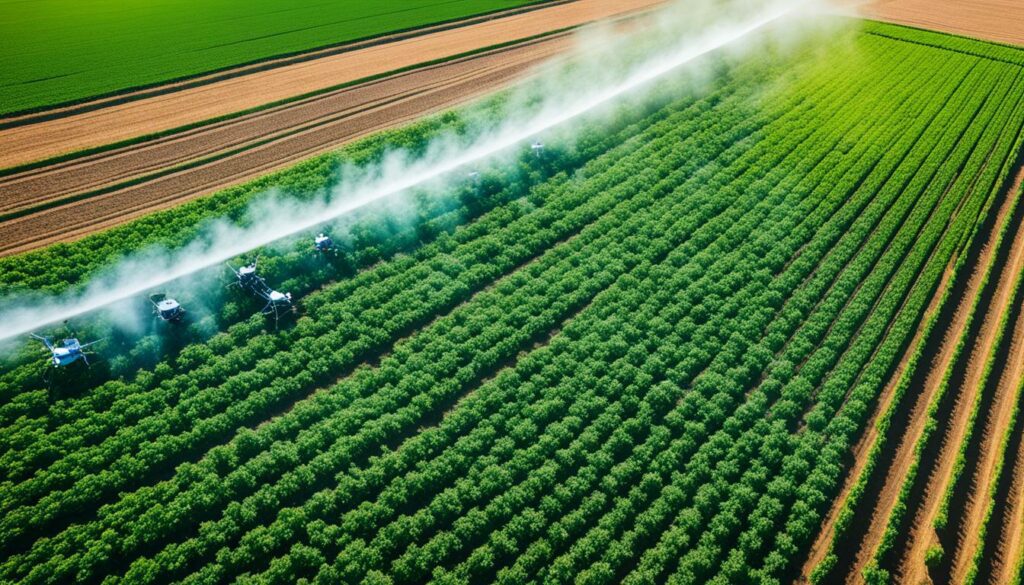
In Mozambique, small farmers saw big improvements thanks to drones. Their crops went up by 41%, and they used water better, increasing by 55%. This shows drone irrigation is good for the farming future.
Precise watering with drones doesn’t just help the environment. It makes farming more efficient too. By spotting signs of pests or diseases early, problems can be handled faster. Drones give farmers a live view of their fields, making it easier to manage crops well.
More and more farmers are using drones. It’s becoming clear that drones are key to farming better with less water. They help get the best out of crops without harming our planet. This moves farming towards a future that’s better for everyone.
In the world of farming today, drones are changing how we use pesticides and fertilisers. They work with amazing precision, making our farming more efficient and kinder to the environment.
Drone systems apply chemicals precisely, making sure crops get exactly what they need. This means less waste and a smaller impact on the planet. Farmers’ costs for fertilisers can also go down by as much as 30%.
Compared to traditional ways, drones work 40% more efficiently. They target crops individually, not in broad strokes. This not only makes crops healthier but also cuts down chemical use’s harm on the environment by 70%.
| Aspect | Traditional Methods | Drone-Enabled Methods |
|---|---|---|
| Application Efficiency | 60% | 100% |
| Chemical Use Reduction | 0% | 70% |
| Labour Cost Reduction | 0% | 50% |
| Crop Yield Increase | 0% | 25% |
Drone spraying is transforming farming, making it safer for farmers and nature. Companies like DJI’s Agras series lead the way in making farming precise, efficient, and green.
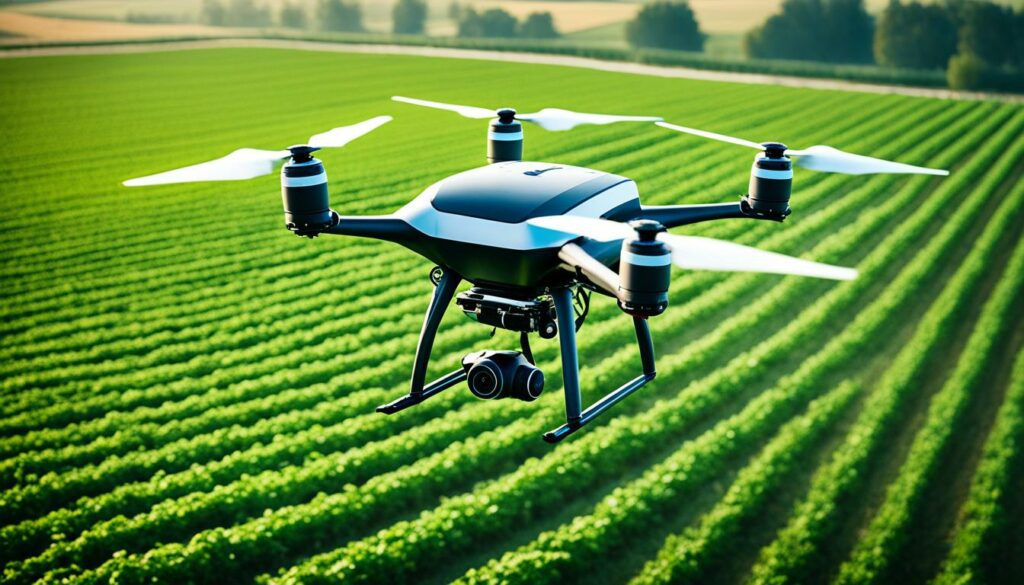
Aerial crop spraying, using drone technology, has changed farming. It provides precise chemical application. The DJI Agras T40 is a leader in this, ensuring pesticides and fertilisers are spread evenly.
In the US, drone operators must get a Remote Pilot Certificate to work commercially. Passing the FAA’s Part 107 test is a must. This training makes sure drones are used safely and effectively, overcoming issues like the weight they can carry and keeping liquids stable.
This drone tech saves a lot of resources. Drones can treat 10 acres in 20 minutes. They adjust the amount of chemical used, which helps the environment and the soil.
Drones are changing the game in eco-friendly farming. They cut down pesticide use by 70% and make farming 30 times more efficient. Less chemicals mean less harm to animals not meant to be affected.
Integrating Haidaagtech’s UAV system takes this efficiency even higher. It uses past data to set the best spray conditions. This means farming gets even better, showing the power of tech in agriculture.
Drones can result in about a 20% increase in food productivity, 70% less pesticide use, 97% water saving, and thirty times more efficiency in farming.
Overall, drones in agriculture bring together tech and farming. The result is better farming that’s good for the planet too.
Farm drone mapping is changing how farmers look after their land. Drones take high-quality pictures from above. These form detailed crop maps for keeping an eye on how crops grow. They also help with making claims when the weather damages crops.
Mapping 100 acres in less than 15 minutes is now possible with drones. This is a big deal for farming. These detailed crop maps help farmers and those who grow seeds to make smart choices quickly. They use special drone pictures to see how healthy the crops are. This helps make sure crops are growing well.
With drones, it’s easier to arrange fields in the best way. They give a very clear view of the land. For example, the DeltaQuad Evo can fly for a long time and take great pictures. Combining this with tools like Pix4Dfields is great for planning where to put fertiliser or where to spray pesticides.
Gathering all this visual data in one place is a great help for farm managers. Drones can take thousands of pictures in one flight. This level of detail is key for using land wisely. It helps to have a farming that doesn’t waste resources.
Agricultural robotics are changing how we farm. They work hand-in-hand with smart farm tech. This makes farming more efficient and productive. appHarvest, for example, uses AI and robots to cut water use and increase crop harvests. They’re on a mission to provide fresh produce to 70% of America in just one day.
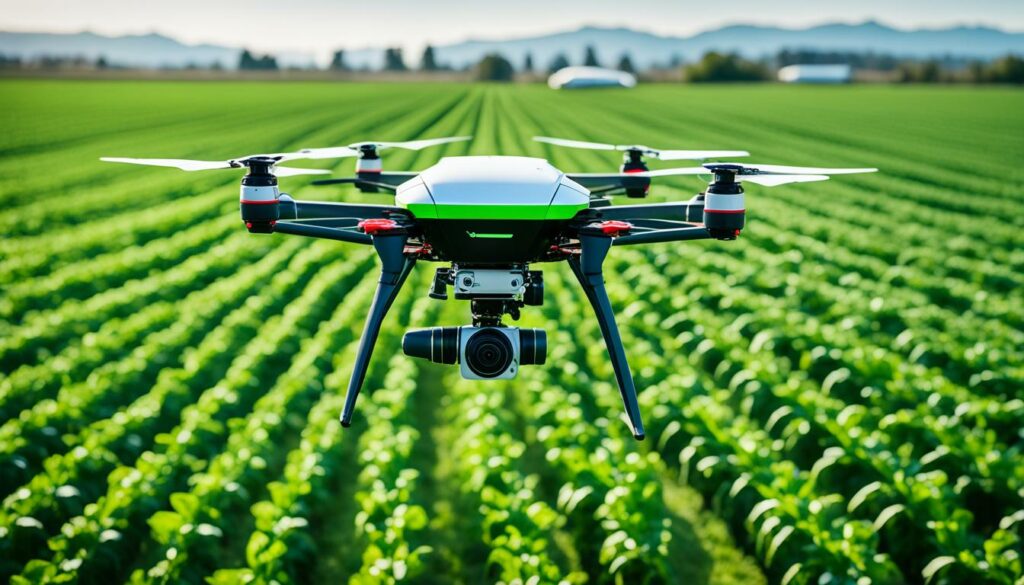
FFRobotics has designed a speedy fruit harvester. It’s said to outpace human pickers by ten times. This invention cuts down on the need for workers, achieving a 98% accuracy in picking fruit. Another cool robot is the LaserWeeder by Carbon Robotics. It uses AI and computer vision to remove weeds without harming the plants.
Bowery Farming in New York is making big changes too. By using robotics, AI, and LED lights, they’re reducing water use by 90 to 95%. Harvest CROO has a robot that picks strawberries ultra-fast. It can pick a plant in eight seconds and move to the next in just 1.5 seconds.
The future looks bright for farming with robots. As the world’s population grows, we need more food. The FAO thinks farming will need to increase by a third by 2050. This is where advanced farming tools like robots come in. They help farmers produce more while using fewer resources.
Drones are changing the game in disaster response, especially in farming. They offer a quick way to check the damage and start fixing things after floods or wildfires. These flying machines help right after the disaster, making them key assets.
Drones are equipped with top-notch cameras and sensors. This lets emergency teams see the damage fast. It’s especially helpful for checking big areas or important places hit by disaster. In places like California, drones are essential for finding and stopping wildfires thanks to special sensors. Plus, they can reach places that are hard for people to get to. This gives a full picture of the damage, helping to make smart decisions. It also helps decide where to focus efforts and resources first.
After the first look, taking action fast is important to stop more damage. Drones help in this by giving real-time information. This allows teams to focus on the most critical areas quickly. Drones are cheaper to use than big aircraft, saving money to help more in the affected areas. Insurance firms also use drones to check the damage and speed up the claim process. They help plan better for the next disaster too, making disaster responses with drones fast and effective.
Today, agriculture is changing thanks to data-based decisions. Farmers use technologies like drones and IoT sensors to collect big data. This data is then carefully looked at to get exact insights into the farm’s processes. This helps in making very accurate choices in farming.?
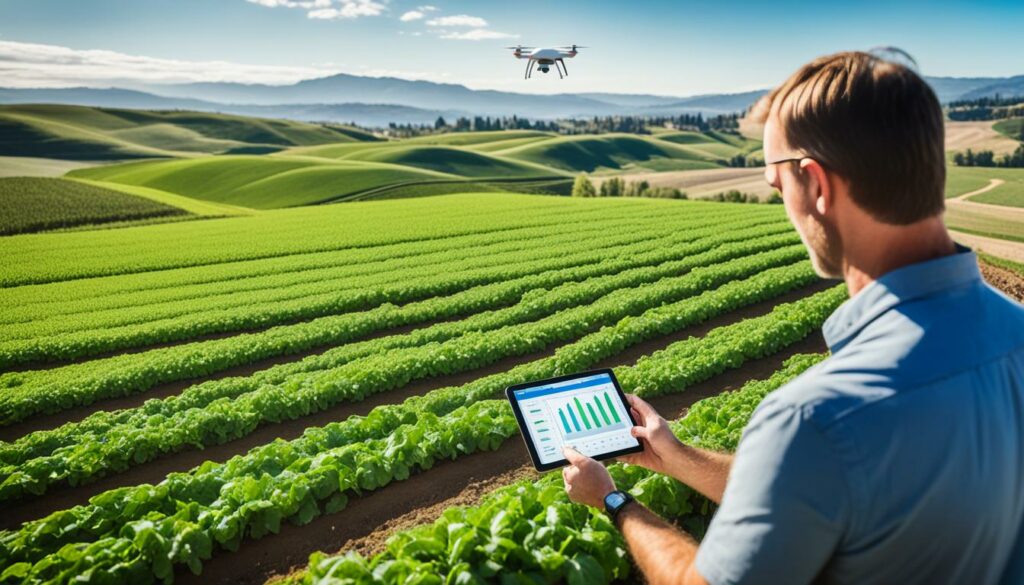
Tools for precision agriculture are very important now. They make farming more efficient and eco-friendly. For example, drones with special cameras can take detailed pictures of crops and gather data in real time. This helps farmers check the health of their crops, notice problems early, and decide better on things like water and fertiliser use.?
The way different systems on farms can easily share information is a big plus for smart farming. It helps share important data easily across the farming and food industries. When this sharing happens smoothly, farming gets more efficient and we can use our resources better. This is really important because our world needs more food.?
Using data in farming has lots of good points. It means better advice for growing crops, improved money management, and following rules more easily. And by working better with others, like partners, the whole farming supply chain can get better. Data helps put the best farming choices in place and makes the industry stronger and more eco-friendly.?
IoT sensors and tech for computer imaging are also making big changes on farms. These technologies help manage and use farming resources better. They make it cheaper for farms to get useful software. This software helps with farming from planting to selling.?
The time from making software to putting it to use can be between 12 and 24 months. So, it’s important that companies offer these solutions when they are needed. Technology is helping big seed firms do everything from research to selling, making sure their products are real and easy to trace. This also helps stop fake products getting out.?
| Technology | Benefit | Impact |
|---|---|---|
| IoT Sensors | Real-time data collection | Enhanced resource management |
| Agricultural Drones | High-resolution imaging | Precision agriculture decision making |
| Robotics | Automated farming tasks | Increased efficiency |
| GPS Systems | Accurate tracking | Effective field management |
Data-driven farming gives farmers the detailed knowledge they need. This helps make farming more precise and sustainable. As time goes on, these ways of using data will keep helping farming to improve.?
Agricultural drones, or UAVs, are changing how we look after livestock. They bring many benefits. These include better monitoring and keeping animals safe and secure.
UAVs help keep an eye on animal health all the time. They use cameras and thermal imaging. This gives us live views of livestock over large areas. They check body temperatures and how animals eat.
Early illness signs can be spotted fast. This means we can act quickly. UAVs also help figure out where the best food and water is. This ensures animals get what they need.
Livestock safety and security matter a lot. UAVs help with this too. They make tasks like herding livestock easier.
This lowers risks like too much grazing and harming the land. UAVs watch animals closely with their cameras. They quickly spot if any animal is hurt or if there’s a new baby (birth).
They are a big help if animals are lost or if there’s a flood or fire. Drones can quickly look through large areas. This helps find missing or stolen animals. It makes farms safer.
UAV systems also have special sensors. These check and map water. This helps manage water well. Good water management is good for the animals and the farm land. It makes farming more sustainable.
This tech also cuts down on work and makes farming more efficient. It’s a big step forward for livestock farming. It shows how technology and care for animals can go hand in hand.
| Key Benefit | Description |
|---|---|
| Real-Time Surveillance | Providing real-time visuals and data on livestock health and behaviour. |
| Early Disease Detection | Monitoring body temperatures and feeding patterns to detect early signs of illness. |
| Enhanced Security | Tracking livestock movement and identifying anomalies quickly and efficiently. |
| Reduced Labour Costs | Automating tasks like herding and monitoring to save on labour costs and increase efficiency. |
| Resource Optimisation | Using precise data to optimise feeding, watering, and pasture management practices. |
In summary, using UAVs to manage livestock is game-changing. It uses the latest tech to keep animals healthy and safe. It also shows how important efficiency and sustainability are in farming today.
Being part of sustainable farming, I’ve seen how drones can change the game. They make farming friendlier to the planet by making operations precise and efficient. With drones, quick decisions and actions are possible thanks to fast image processing.
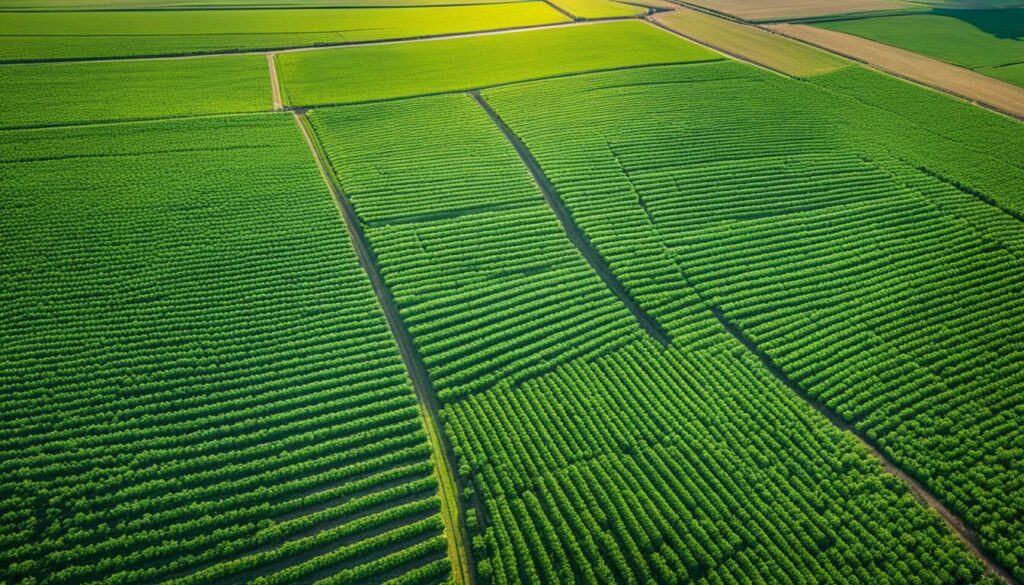
Drones are a big win for the environment. They let us aim water and chemicals precisely, cutting waste and harm to nature. This is key as we fight climate change, aiming to reduce Europe’s 2050 agriculture loss.
In the money game, the drone market’s value is set to soar to US$32.4 billion. Drones can check plant health and spot pests early, making farming greener. In the UK, there’s a big push to make farming carbon neutral by 2040. Drone technology is a big part of this drive.
Drones also help use resources smarter by giving detailed data for precise farming. Some drones can map areas much quicker, which means we get clear, detailed images fast. Brands like DJI and Hylio lead the way in making farming more sustainable and productive.
The global precision farming market could hit $43.4 billion by 2025, partly thanks to drones. These high-tech tools support efficient, green farming practices. By using drones, we’re ensuring our farms last, keeping food safe for the future.
Drone technology has changed agriculture in big ways. It has made farming more efficient and friendly to the environment. It’s clear that drones are here to stay and are leading us towards a better farming future.
Farmers and experts need to keep up with drone technology. In the US, for example, they need a license from the FAA to fly drones for farming. This is to make sure they fly safely and well.
The use of drones in farming is growing fast. It’s expected that by 2024, the market for agricultural drones will be worth $4.8 billion. Drones can help increase crop yields and are making farming more efficient, especially in places like South Korea. Here, drones are used a lot for spraying crops, saving money and protecting the environment.
Drone technology is being used for planting trees too. In Australia, they use special sensors to check the health of the soil. And as scientists work on new drone features, like helping crops grow better, there’s a lot more they can do.
To sum up, drones are changing the future of farming for the better. They help make farming more efficient and friendlier to our planet. By using drones, farming can be profitable and keep up with what the world needs. Their use in modern farming is becoming very important.
Agricultural drones, or ‘ag drones’, are high-tech devices. They fly without a pilot and come with advanced cameras. These drones help farmers manage their crops and farms better.
Drones capture high-quality images and real-time data. They check crop health, soil, and water needs closely. This information guides farmers to use resources better and increase their farm’s productivity.
Drones give farmers a bird’s-eye view of their crops. They can detect diseases and see what nutrients and water the plants need. This real-time overview improves crop health and farm efficiency.
Remote sensing uses special cameras and sensors to look at crops in detail. It tells farmers about the health of their plants and the area around them. This information helps them take action at the right time, making their farms better managed.
A: Drone-based irrigation is very precise in applying water to crops. It cuts water waste and is good for the environment. By using water carefully, more crops grow, and the environment is less harmed.
Drones spray pesticides and fertilisers very precisely. This approach uses less chemicals and money. It also makes farming friendlier to the environment.
Aerial spraying is when drones spread pesticides or fertilisers over fields. They do it accurately, using less chemicals. This helps farmers care for the environment and their crops better.
Drone mapping helps farmers see their crops in detail. They can plan better and use their land more effectively. This leads to better use of resources and a more efficient farm.
Agricultural robotics, like drones, make farming smarter and more efficient. They bring advanced tools that fit into the daily work on a farm. This way, they promote automation and smart farming.
Drones quickly show the damage after disasters like floods or fires. They provide important data for fast decisions. This helps save crops and protect farmers’ livelihoods.
By using drones and high-tech imaging, farmers get detailed information. This data helps them make better choices. It improves the farm’s productivity and helps in using resources wisely.
Drones keep an eye on the health and safety of farm animals. They provide clear images and data. This helps spot health issues or dangers quickly, keeping the animals safe.
Drones help farmers use water and chemicals more efficiently. This reduces harm to the environment. They support farming practices that are good for the earth, ensuring a better future for agriculture.